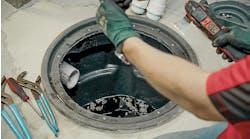Third in a series.
I SET UP MY own unscientific re-search to compare different insulation products used in snow-melt systems, as you'll recall from last month's column ("More answers on snow-melt insulation," pg. 40).
Each insulation sample was monitored for temperature differential between the two sensors above and below the sample insulation coupon. That data was collected during an actual snowstorm to avoid wasting fuel and so we could monitor results during real-world design conditions. The data collected and boiled down represents a 36-hour timeframe that started during the middle of the storm and stopped near the end of the storm.
The data was then reduced to a simple number using simple math. The temperatures above the insulation minus below the insulation equals the temperature differential between the two. Those insulation systems with the greatest differential in temperature show the greatest savings potential for that particular operating condition.
The system was not monitored during any long-term "idle" conditions. I guess that if someone wanted to come up with the cash necessary to compensate the homeowners for their natural gas expenses, it could have been done. Such are the pitfalls of urban guerrilla re-search. The mathematical results are:
Sample 1, bubble foil bubble, 4.63°F differential;
Sample 2, EPS with bubble foil bubble, 8.59°F differential;
Sample 3, 1-in. thick 25-PSI XPS, 10.24°F differential;
Sample 4, Insultarp, 8 .52 °F differential;
Sample 5, The Barrier, 6.54°F differential; and
Sample 6, 1 /2-in. thick EPS fanfold foam with reflective foil, 5.8°F differential.
Each insulation has its own nuances and appeal that vary by application and applicator. Some people like to use the bubble-foil-bubble product because of the ease of rolling it out for installation. Some contractors tape the joints together, some don't. It does work well in situations where the ground is rough or uneven, contouring to the lay of the land quite nicely.
The EPS products have a tendency to fracture easily if applied to uneven or rocky subsurface soil conditions.
The XPS product, although somewhat tougher than its cousin the EPS so it can withstand more foot traffic, is more labor intensive when it comes to putting the insulation in place, especially when being used on curved or irregular applications. More information on this product can be seen at www.owenscorning.com/around/insulation/products/foamular.asp
Users of Insultarp say that it is as easy as the bubble-foil-bubble product to roll out, but it also requires labor-intensive work cutting it to fit curved curb applications. Additional information on this product can be seen at www.insul-tarp.com/products/InsulTarp/
The Barrier claims to be as easy as the other roll-out insulations to install, comes with a self-adhesive overlapped edge and the manufacturer claims to have a higher resistance value based on its own research, with laboratory results to prove its claims. Additionally, The Barrier has high moisture resistance capabilities, so it acts as both the moisture barrier and thermal barrier. Additional information can be obtained at www.nofp.com/barrier.html
The 1 /2-in. fan fold EPS product is the brainchild of Matt Carr and his local affiliates in the foam industry. His users like the ease of installation, especially in tight situations where they can easily carry large bundles of the insulation into the jobsite under their arms. Additional information on this product can be obtained by contacting Carr at [email protected].
TVM Building Products manufactures the bubble-foil-bubble and bubble-foil-bubble/EPS products under the name rFoil. More details on its products can be seen at www.tvmi.com/rfoil/
Another important factor to consider when deciding which insulation best suits your needs is the crush resistance of the insulation material. You must look at all the parameters of compressive strength and resistance to crushing to make certain that the product is appropriate for the application. A slab dropping 1 /2 in. could spell disaster for snow-melt systems causing potential tubing pinch off and a lack of required flow to maintain proper surface temperatures.
You must also consider the basic cost of the insulation, the labor of installation and, in the near future, code authority acceptance and suitability of the material for that application.
The best insulation for your job depends upon the needs, wants and expectations of you, the contractor, and the consumer. Regardless of your choice, please do your part to reduce your carbon footprint upon the face of the earth by using insulation wisely!
Mark Eatherton is a Denver-based hydronics contractor. He can be reached via e-mail at [email protected] or by phone at 303/778-7772.

